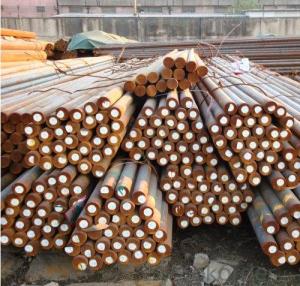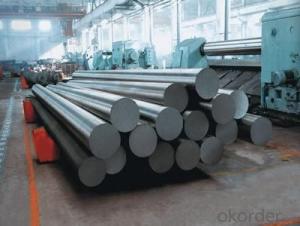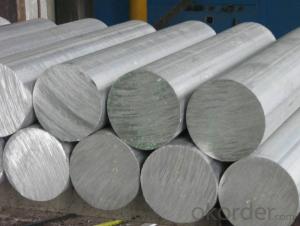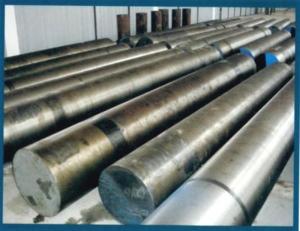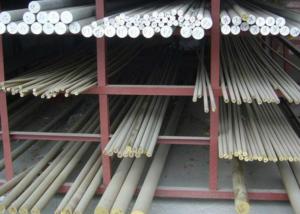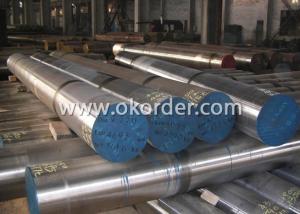Hot Forged 1045 Carbon Round Steel Bar with black/turned/grinded
- Loading Port:
- China main port
- Payment Terms:
- TT OR LC
- Min Order Qty:
- 25 m.t.
- Supply Capability:
- 1000 m.t./month
OKorder Service Pledge
OKorder Financial Service
You Might Also Like
Item specifice
Hot forged 1045 carbon round steel bar with black/turned/grinded
Product information
1. Produce Standard: GB, AISI, ASTM, SAE, EN, BS, DIN, JIS
2. Produce processes: Smelt Iron -EAF smelt Billet - ESR smelt Billet -Hot rolled or forged get the steel round bar and plate
3. Heat treatment: Normalized / Annealed / Quenched+Tempered
4. Quality assurance: All order we can received third party inspection, You can let SGS, BV,.. and others test company test and inspect our products before Goods shipping.
Product detail
| Material | AISI 1045, S45C, C45, 1.0503, 45 | Round bar | Dia(mm) | Max 700 |
| Process | EAF + LF + VD + Forged + Heat Treatment (optional) | Length (mm) | Max 12000 | |
| Heat treatment | Normalized / Annealed / Quenched / tempered | Plate bar | Thickness(mm) | Max 200 |
| Delivery condition | Hot forged +Rough machined (black surface after Q/T)+ Turned (optional) | Width(mm) | Max 3000 | |
| Test |
Product show

Work shop
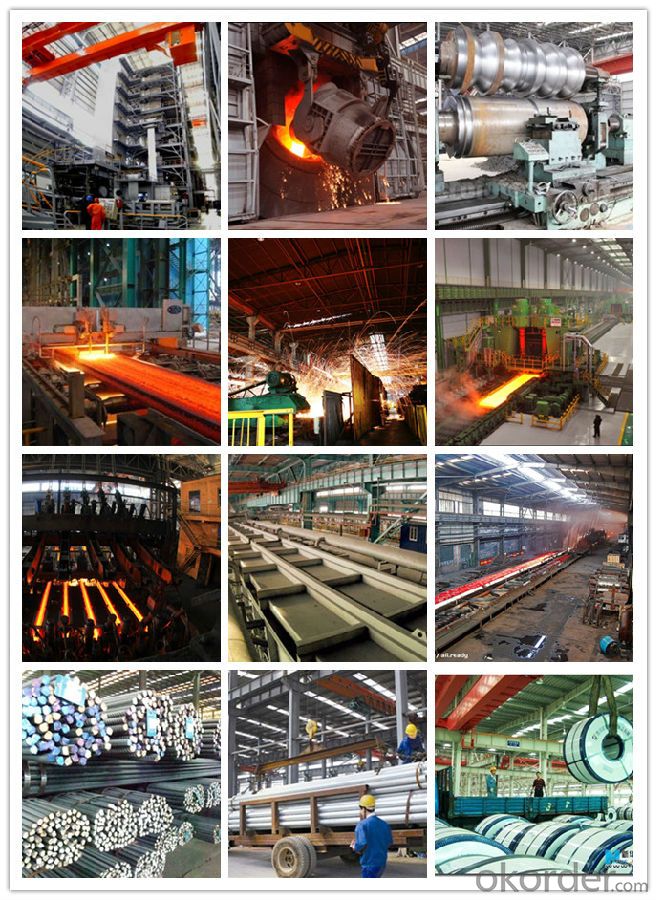
Our Services
* Welcome to contact us with your detailed inquiry, you will be replied within 24 hours.
* You are promised to obtain the best quality, price and service.
* We'd like to provide samples for your confirm.
- Q:Can special steel be used in food processing applications?
- Yes, special steel can be used in food processing applications. Special steel, such as stainless steel, is commonly used in the food industry due to its excellent corrosion resistance, hygienic properties, and durability. It is safe for food contact, easy to clean, and does not react with acidic or alkaline substances.
- Q:What are the different methods for electroplating special steel?
- To electroplate special steel, various methods can be employed based on specific requirements and desired outcomes. The following are some commonly utilized techniques: 1. Electroless Nickel Plating: Achieving uniform and corrosion-resistant coatings on special steel is possible through this method, which entails depositing a layer of nickel onto the steel surface using a chemical reaction. 2. Zinc Plating: A protective layer is provided to special steel through the immersion of the steel in a zinc solution and the passage of an electric current, facilitating the deposition of zinc onto the surface. 3. Copper Plating: Enhancing conductivity and corrosion resistance of special steel can be achieved by immersing the steel in a copper sulfate solution and applying an electric current to deposit a layer of copper onto the surface. 4. Chromium Plating: This method is commonly employed to confer a decorative, corrosion-resistant, and hard-wearing surface on special steel. It involves immersing the steel in a chromium bath, and an electric current is applied to deposit a layer of chromium onto the surface. 5. Electroplating with Precious Metals: For decorative or functional purposes, special steel can be electroplated with precious metals like gold, silver, or platinum. These coatings enhance the appearance, conductivity, or corrosion resistance of the steel. 6. Electroplating with Alloy Coatings: Special steel can be electroplated with alloy coatings, such as tin-zinc or tin-lead, for specific applications that require unique properties like enhanced solderability or improved wear resistance. It is important to consider factors such as desired properties, intended application, and specific requirements of the special steel being plated when selecting an electroplating method. Each method has its advantages and limitations, making it advisable to consult experts in the field to determine the most suitable technique for electroplating special steel in a given scenario.
- Q:What are the different methods of analyzing the microstructure of special steel?
- The microstructure of special steel can be analyzed using various methods. These methods involve examining and characterizing the steel at a microscopic level to gain insights into its composition, grain structure, and other features. Some commonly used methods include: 1. Optical Microscopy: By using light microscopy, the microstructure of special steel can be observed. This method allows for the identification of different phases, grain boundaries, inclusions, and other features. It provides valuable information about the size, distribution, and morphology of constituents in the steel. 2. Scanning Electron Microscopy (SEM): SEM is a powerful technique that utilizes a high-energy electron beam to analyze the microstructure of special steel. It offers detailed information about the steel's surface topography, morphology, and elemental composition. SEM is particularly useful for studying precipitates, segregation, and other microstructural defects. 3. Transmission Electron Microscopy (TEM): TEM is an advanced technique that enables analysis of the microstructure at a higher resolution compared to optical and SEM methods. It involves the transmission of electrons through a thin sample, providing information about the crystal structure, dislocations, and other fine details of the microstructure. TEM is especially beneficial for studying nanostructures and interfaces in special steel. 4. X-ray Diffraction (XRD): XRD is a non-destructive method that utilizes X-rays to analyze the crystal structure and identify phases in special steel. It provides information about the crystallographic orientation, grain size, and phase composition of the steel. XRD is widely used for analyzing phase transformations and residual stress in special steel. 5. Electron Backscatter Diffraction (EBSD): EBSD combines SEM with crystallographic analysis to provide information about the crystal orientation, texture, and grain boundaries in special steel. It is useful for studying deformation mechanisms, recrystallization, and grain growth in the steel. 6. Energy Dispersive X-ray Spectroscopy (EDS): EDS is often used in conjunction with SEM or TEM to analyze the elemental composition of special steel. It provides information about the presence and distribution of different chemical elements in the microstructure, aiding in the identification of phases and characterization of inclusions. These methods, among others, offer valuable insights into the microstructure of special steel. They enable researchers and engineers to understand the steel's properties, performance, and potential applications.
- Q:What are the different coating techniques for special steel?
- There are several different coating techniques that can be used for special steel to enhance its properties and protect it from corrosion or wear. Some of the commonly used coating techniques include: 1. Electroplating: In this technique, a thin layer of metal is deposited onto the surface of the steel using an electric current. This can be done with various metals such as zinc, nickel, or chrome, depending on the desired properties of the coated steel. 2. Hot-dip galvanizing: This technique involves immersing the steel in a molten zinc bath, which forms a protective layer on the surface. Hot-dip galvanizing is commonly used for outdoor applications, as it provides excellent corrosion resistance. 3. Powder coating: In this technique, a dry powder is applied to the surface of the steel and then heated to form a protective coating. Powder coating offers a wide range of colors and finishes and provides both corrosion and wear resistance. 4. Thermal spraying: This technique involves heating a coating material, such as zinc or aluminum, to a high temperature and then spraying it onto the steel surface. Thermal spraying is commonly used for high-temperature applications, as it provides excellent resistance to heat and corrosion. 5. PVD coating: Physical vapor deposition (PVD) is a technique where a thin film of metal is deposited onto the steel surface through a vacuum process. PVD coatings can provide various properties such as hardness, wear resistance, and decorative finishes. 6. Carbonitriding: This is a surface hardening technique where the steel is heated in a furnace containing a carbon and nitrogen-rich atmosphere. Carbonitriding forms a hard, wear-resistant layer on the steel surface, improving its durability. These coating techniques offer different advantages and are chosen based on the specific requirements of the application. By applying these coatings, special steel can be made more resistant to corrosion, wear, and other forms of degradation, extending its lifespan and enhancing its performance in various industries.
- Q:Can special steel be used in the construction equipment manufacturing industry?
- Yes, special steel can be used in the construction equipment manufacturing industry. Special steel is known for its high strength, durability, and resistance to wear and corrosion, making it an ideal material for producing heavy-duty construction equipment such as excavators, bulldozers, cranes, and loaders. Additionally, special steel can be customized to meet specific requirements, ensuring the construction equipment meets the necessary performance and safety standards.
- Q:How does special steel perform in hydrogen embrittlement conditions?
- Special steel, also known as high-strength steel or alloy steel, typically exhibits excellent resistance to hydrogen embrittlement conditions. Hydrogen embrittlement is a phenomenon in which hydrogen atoms invade the metal's lattice structure, causing it to become brittle and prone to fractures under stress. Due to their unique composition and microstructure, special steels are designed to withstand harsh environments, including hydrogen embrittlement conditions. These steels often contain alloying elements such as nickel, chromium, and molybdenum, which enhance their resistance to hydrogen-induced cracking. The presence of these alloying elements in special steel promotes the formation of protective oxide layers on the steel's surface, which act as a barrier to prevent hydrogen atoms from diffusing into the metal matrix. Additionally, these elements can trap and bind hydrogen atoms, reducing their mobility and minimizing their detrimental effects on the steel's mechanical properties. Furthermore, special steels are often subjected to various heat treatments and processing techniques, such as quenching and tempering, to further enhance their resistance to hydrogen embrittlement. These processes help refine the steel's microstructure, improving its strength, toughness, and ductility while minimizing the potential for hydrogen-induced cracking. Overall, special steel demonstrates superior performance in hydrogen embrittlement conditions compared to standard steels. Its unique composition, microstructure, and processing techniques make it highly resistant to the detrimental effects of hydrogen atoms, ensuring the structural integrity and reliability of components and structures operating in hydrogen-rich environments.
- Q:Can special steel be used in the beverage manufacturing industry?
- Yes, special steel can be used in the beverage manufacturing industry. Special steel, such as stainless steel, is commonly used in the beverage industry due to its corrosion resistance, hygiene properties, and durability. It is often utilized for the production of tanks, containers, piping, and other equipment involved in the processing, storage, and transportation of beverages.
- Q:How does special steel contribute to improving product safety in high-risk industries?
- Special steel contributes to improving product safety in high-risk industries by providing enhanced strength, durability, and resistance to various hazardous conditions. Its unique properties, such as high tensile strength, corrosion resistance, and heat resistance, make it an ideal material for manufacturing critical components and structures in industries like aerospace, automotive, oil and gas, and construction. By using special steel, manufacturers can ensure that their products can withstand extreme conditions, reducing the risk of failures, accidents, and potential harm to workers or the environment.
- Q:How does special steel contribute to the manufacturing of gears?
- Special steel plays a crucial role in the manufacturing of gears as it offers exceptional strength, durability, and wear resistance properties. The use of special steel allows gears to withstand heavy loads, high temperatures, and intense friction, ensuring their longevity and reliable performance. Moreover, the precise metallurgical properties of special steel enable gears to maintain their shape and dimensions accurately, resulting in smooth and efficient power transmission in various industries, including automotive, aerospace, and machinery.
- Q:What are the characteristics of special stainless steel?
- Special stainless steel, also known as superalloys, possess several unique characteristics. Firstly, they exhibit exceptional resistance to corrosion, making them highly durable and long-lasting in harsh environments. Additionally, they have high strength and toughness, allowing them to withstand extreme temperatures and pressures. Special stainless steel also demonstrates excellent heat resistance, making it suitable for applications in high-temperature environments. Furthermore, these alloys often exhibit superior chemical stability, resistance to wear and tear, and excellent mechanical properties, making them highly versatile for various industrial applications.
1. Manufacturer Overview |
|
|---|---|
| Location | |
| Year Established | |
| Annual Output Value | |
| Main Markets | |
| Company Certifications | |
2. Manufacturer Certificates |
|
|---|---|
| a) Certification Name | |
| Range | |
| Reference | |
| Validity Period | |
3. Manufacturer Capability |
|
|---|---|
| a)Trade Capacity | |
| Nearest Port | |
| Export Percentage | |
| No.of Employees in Trade Department | |
| Language Spoken: | |
| b)Factory Information | |
| Factory Size: | |
| No. of Production Lines | |
| Contract Manufacturing | |
| Product Price Range | |
Send your message to us
Hot Forged 1045 Carbon Round Steel Bar with black/turned/grinded
- Loading Port:
- China main port
- Payment Terms:
- TT OR LC
- Min Order Qty:
- 25 m.t.
- Supply Capability:
- 1000 m.t./month
OKorder Service Pledge
OKorder Financial Service
Similar products
New products
Hot products
Related keywords
